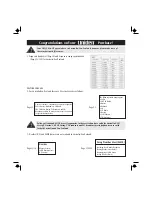
Appendix F - About CTCSS, DCS and P25 NAC
CTCSS, DCS and P25 NAC are terms used to describe the
different types of
selective squelch
that your
0716
is
capable of utilizing with conventional, non-trunked radio
channels.
In many cases, frequencies that are assigned to licensees are
not licensed on an exclusive basis. This means that the
transmitters and receivers operated in one licensees radio
system may be close enough geographically to another licensee
that it is technically possible for the two licensees to hear radio
traffic from each others system. This is especially true for
business radio users, however, it is not all that uncommon for
different public safety licensees to be close enough to each other
for one licensees radio traffic to be heard by another licensee.
Additionally, certain radio propagation events can sometimes
allow radio signals to travel hundreds or thousands of miles
beyond a licensees service area, in some cases, making their
radio transmissions receivable on the other side of the continent.
Reception of traffic from another radio user can be an
undesirable situation, causing confusion and distraction.
Selective squelch is employed in transmitting and receiving
equipment to limit reception to only those transmitters that are
transmitting the correct encoded selective squelch signal. Much
in the same way that a radio licensee can use selective squelch
to block out foreign traffic from their radio receivers, you can use
selective squelch on your
0716
to block undesired traffic
from being received on your scanner. In addition to this basic
selective squelch capability, your
0716
can search for and
display the selective squelch type and squelch tones or codes in
use on a particular frequency.
The three types of selective squelch available in the
0716
are as follows:
CTCSS
CTCSS stands for Continuous Tone Coded Squelch System. In
CTCSS, the transmitter sends a special, low level audio tone
continuously while a transmission is in progress. This is known
as a
subaudible
tone - the level and frequency are such that
they are difficult or impossible to hear in a receivers speaker.
The receiver (or your scanner) will detect and decode this tone,
and if it matches the programmed tone, the speaker will be
unmuted and voice audio allowed to pass. If the tone is not
0716
User Manual
Page 130





































